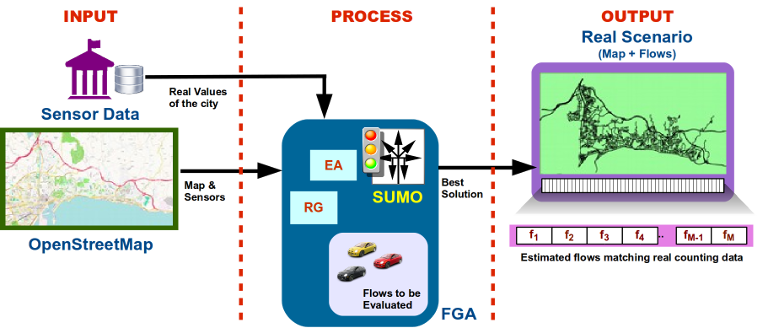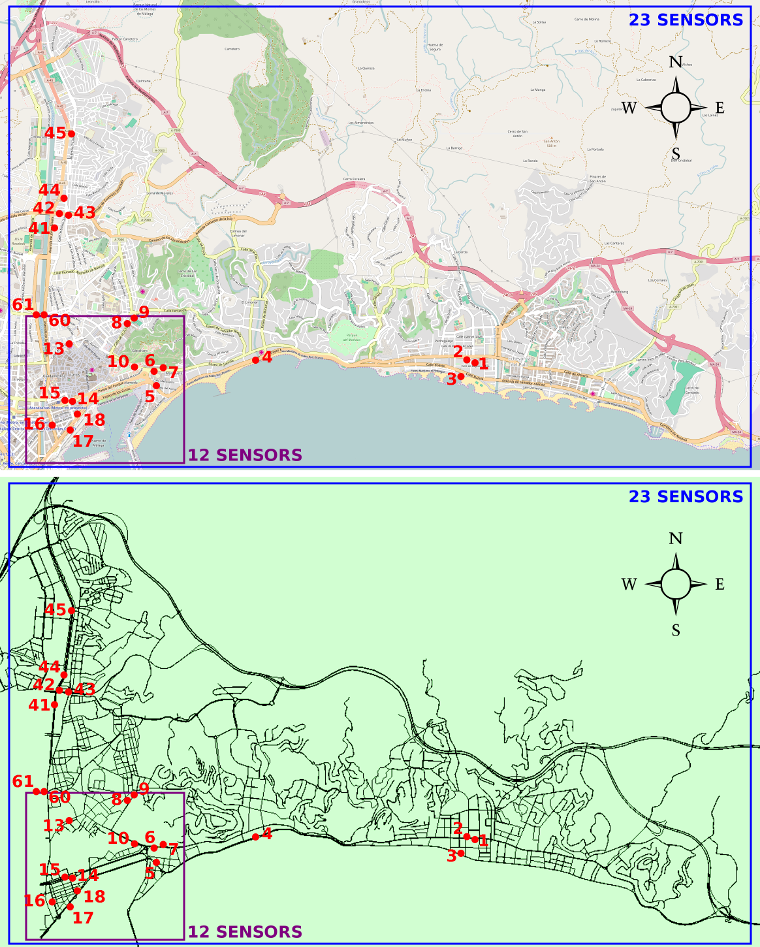Generating realistic urban traffic flows with evolutionary techniques
We present a novel approach for calculating realistic traffic flows for traffic simulators, called Flow Generator Algorithm (FGA). We start with an original map from OpenStreetMap and traffic data collected at different measurement points, published by the city’s authorities, to produce a model consisting of the simulation map and a series of traffic flows (routes + vehicles) which match the real number of vehicles at those streets. Our approach does not need a full dataset to calculate the flows. In fact, just a few measurement points indicating the number of vehicles in the analyzed time interval were used. This and the use of evolutionary algorithms for such a complex task make our proposal different from the studies found in literature. Despite the fact we have chosen the SUMO traffic simulator for our experiments, this idea can be easily adapted to others. We have tested our proposal on two geographical areas of the city of Malaga, comprising different map sizes, number of sensors and vehicles, and have achieved measurement values from the simulation that are closer to the real values, showing an error lower than 10%. Our algorithm, as well as the realistic scenarios generated by using it, can be used as the basis for other research approaches, especially those focused on road traffic optimization.


Publications:
Daniel H. Stolfi and Enrique Alba. Generating realistic urban traffic flows with evolutionary techniques. In: Engineering Applications of Artificial Intelligence, vol. 75, pp. 36-47, 2018.
doi> 10.1016/j.engappai.2018.07.009 | [BibTex] | [Files]@article{STOLFI201836, title = "Generating realistic urban traffic flows with evolutionary techniques", journal = "Engineering Applications of Artificial Intelligence", volume = "75", pages = "36 - 47", year = "2018", issn = "0952-1976", doi = "10.1016/j.engappai.2018.07.009", url = "http://www.sciencedirect.com/science/article/pii/S0952197618301532", author = "Daniel H. Stolfi and Enrique Alba", keywords = "Evolutionary algorithm, Traffic simulation, Smart mobility, SUMO, Road traffic optimization, O–D matrix", }Daniel H. Stolfi and Enrique Alba. An Evolutionary Algorithm to Generate Real Urban Traffic Flows. In: Advances in Artificial Intelligence, in Lecture Notes in Computer Science. Cham: Springer International Publishing, 2015, pp. 332-343.
doi> 10.1007/978-3-319-24598-0_30 | [BibTex] | [Slides]@InProceedings{Stolfi2015, author = {Stolfi, Daniel H. and Alba, Enrique}, booktitle = {Advances in Artificial Intelligence}, title = {{An Evolutionary Algorithm to Generate Real Urban Traffic Flows}}, year = {2015}, address = {Cham}, editor = {Puerta, Jos{\'{e}} M and G{\'{a}}mez, Jos{\'{e}} A and Dorronsoro, Bernabe and Barrenechea, Edurne and Troncoso, Alicia and Baruque, Bruno and Galar, Mikel}, pages = {332--343}, publisher = {Springer International Publishing}, series = {Lecture Notes in Computer Science}, volume = {9422}, doi = {10.1007/978-3-319-24598-0_30}, isbn = {978-3-319-24597-3}, keywords = {Evolutionary algorithm, SUMO, Smart city, Smart mobility, Traffic simulation, smart mobility}, }
This research was partially funded by the Spanish MINECO and FEDER projects TIN2014-57341-R (moveON), TIN2016-81766-REDT, and TIN2017-88213-R (6city). Daniel H. Stolfi was supported by a FPU grant (FPU13/00954) from the Spanish Ministry of Education, Culture and Sports.




